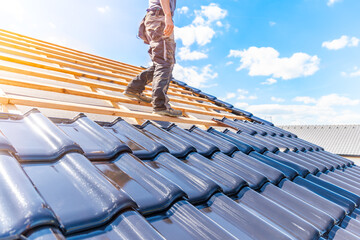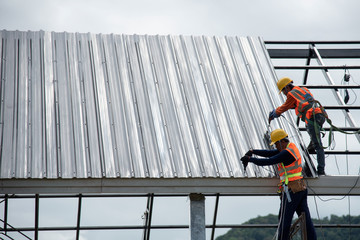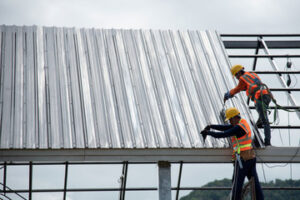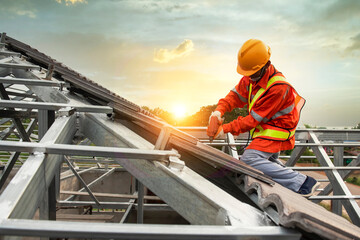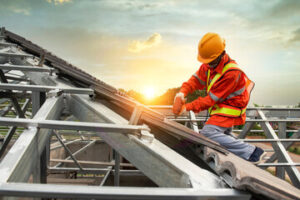Getting a new roof is an expensive investment, but one that will improve the value of your home. If your existing roof has moderate damage, it may be more cost effective to reroof only the affected areas.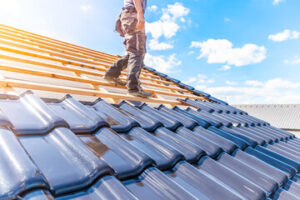
Proper roofing installation requires preparing the work area, installing underlayment, and constructing the outer layer of shingles or tiles. These steps will ensure a durable, watertight ridge and protect the home from leaks. Visit www.fivestarroofingandcontracting.com to learn more.
A roofing contractor will conduct a preliminary inspection to evaluate the state of your roof. They’ll consider factors like the extent of damage, your budget and long-term financial goals, and whether your roof is exhibiting signs of wear and tear that warrant immediate repair or replacement.
During this visit, your roofing contractor will also discuss how to prepare for the project. This might include clearing access points around your home for workers and removing items from walls or shelves that could fall during construction. They’ll also provide safety measures and set expectations for noise, dust, and work hours.
Depending on the size and complexity of your roof, the initial inspection may take up to a few hours. This includes examining both the exterior and interior of your roof. They’ll look for any signs of damage or deterioration, as well as check the condition of gutters and downspouts. They’ll also assess attic space for signs of water intrusion or moisture damage.
Once the inspection is complete, your roofing contractor will provide a detailed report outlining the findings and their recommendations. The report will include a breakdown of costs and an estimated timeline for the installation process. Review this document carefully and ask for clarification on any points you don’t understand.
Once the inspection is complete, your roofing contractor can start planning the materials and logistics for the project. They’ll handle obtaining any necessary permits, and they’ll coordinate with local authorities to ensure that your roof is in compliance with building codes and regulations. In addition, they’ll usually take this opportunity to install new vents and add a drip edge at the eaves of your roof. This will protect the sheathing and help prevent ice dams and water leaks. In some cases, your roofing contractor may choose to apply an ice and water barrier or tar paper to the roof decking for extra protection against leaks. In this case, they’ll also install a drip edge at the eaves and cover any exposed sheathing with caulking.
Materials Selection
The type of roofing material a homeowner selects depends on a number of factors. These include aesthetics, durability, energy efficiency, and initial cost. Other considerations are local building regulations and homeowners’ association guidelines. For example, some communities may require that roofing materials align with certain architectural styles or colors. A homeowner’s home improvement budget also influences the selection process, as does the level of maintenance required.
The level of difficulty and simplicity in installing a particular roofing material also impacts the decision-making process. For instance, shingles are relatively easy to install, but metal panels can be more challenging. Roof slope can also impact the type of roofing material selected, as steeper roofs require a stronger and more durable material than lower slopes.
Once the roofing material is selected, the roofers begin installation. This stage involves applying underlayment and flashing materials, depending on the roofing system. Underlayment is a layer of waterproof material that protects the structure of a roof from moisture infiltration. It is typically installed over a drip edge, which protects the lower edges of a roof from water leaks. A good roofer will use plenty of underlayment, particularly in vulnerable spots like around chimneys and vents.
If a homeowner chooses to go with a flat roof, a membrane is used to prevent water from collecting in the eaves. EPDM is the most common flat-roof membrane. It is available in large sheets, which minimizes seams and makes it less prone to leaks. Another option is TPO (thermoplastic polyolefin). Like EPDM, it is flexible and lasts 10-15 years.
As a final step, ridge flashing is installed to protect the ridge of the roof. This includes a cap that covers the roof’s peak, as well as a strip of weatherproof material that goes under the shingles and seals at the shingle-edge.
A top-tier roofer will also use a variety of finishing touches to enhance the appearance of the new roof. These may include the addition of a drip edge, decorative ridge caps, and fascia trim. They will also inspect and repair the gutter system.
Permits
In many jurisdictions, including Massachusetts, a permit is required for any significant work performed on your roof. Generally, this includes a full replacement or substantial repairs. However, the specifics of what needs to be done can vary, so it’s always best to check with your local authority. If you have a homeowners association, for example, they may have additional requirements that need to be met regardless of the scope of your project.
Depending on state regulations and the local building code, permitting is also often required for other projects like adding home additions, remodeling, installing new electrical or plumbing fixtures, and doing extensive tree trimming and removal. Adding skylights and energy-efficient upgrades also falls under this category. Permits aren’t just a legal formality; they help guarantee that any significant work meets safety standards and other requirements. They’re also a safeguard against complications during appraisals or home sales, and insurance claims can be denied for unpermitted work.
Before hiring a contractor, it’s important to ask them about their permit process. This is particularly true if you’re thinking about doing a large scale renovation or if your home is part of an HOA. It’s also a good idea to ask them what type of waste they generate during the job and how they handle it. Construction sites create a lot of waste, and it’s important that they dispose of it safely in accordance with local regulations.
If your contractor is a residential roofing specialist, they’ll have a specialized license in this area. If they perform any other type of residential work, they’ll need a general residential contractor’s license, and they’ll have to register with the Department of Consumer Protection and get a workers’ compensation bond in the amount of $100,000.
You’ll also want to find out if your contractor is licensed by the state, which is not necessary in Massachusetts. However, it’s important to keep in mind that the state requires a workers’ compensation bond for all contractors working on homes. You can learn more about this requirement by visiting the website of the Department of Labor and Industries.
Installation
It’s install day, and the roofers should arrive on time, wearing hard hats and protective clothing. You may need to move plants, cover them with tarps or leave them indoors for their safety and your own (pets should remain inside too). They’ll begin by checking the existing roof decking for damage and then installing any needed ventilation and insulation. Next, they’ll install the new roofing materials, followed by flashing and sealing to protect vulnerable areas like roof valleys, chimneys, wood stove pipes, vents, and hip roofs. Throughout the installation process, open communication is vital to address any questions or concerns.
